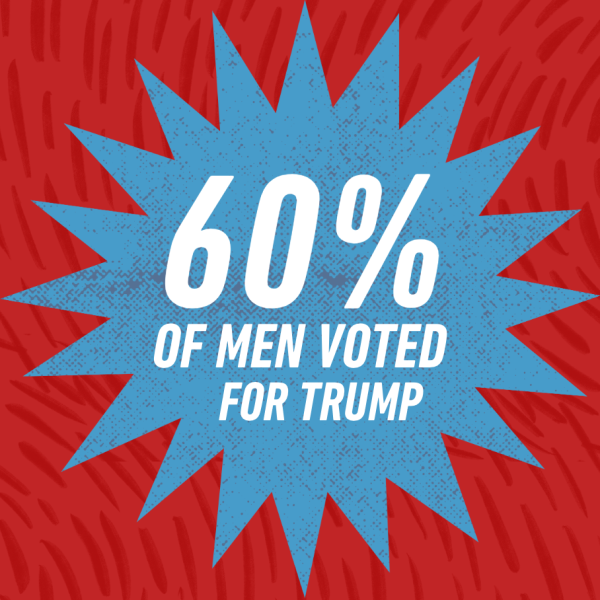For Americans on both sides of the aisle left grappling with the results of the contentious 2024 presidential election, one word sums up the events of Nov. 5: unprecedented.
On the eve of the election, just hours before the polls opened, Vice President Kamala Harris held a four point lead over former president and convicted felon Donald Trump. But the polls have missed before…and they missed again. Trump cleared a victory as the 47th president of the United States, along with a Republican sweep in both the House and Senate.
It’s clear that a silent majority had a hand in the Republican’s victory, evading polls and predictions to deliver a shocking blow on the night of the election.
But who exactly comprises this silent majority?
The answer, unsurprisingly, is men.
Nearly 60% of white men voted for Trump, followed by 54% of Latino men as the biggest backers of the Republican party, an exit poll by NBC revealed. Women, particularly women of color, voted the opposite, with Black and Latino voters showing up for the Vice President in her bid for office.

This pivotal election was more than just a fight between red and blue—it was a fight between women and men, won by the latter to preserve the one thing they’ve always held onto: power.
Trump’s campaign was strategic—more so than many believed–and ultimately gave him the male backing he needed to secure a win. In recent years, elections have turned to social issues as a way to appeal to young voters, leveraging promises of equality and identity politics to win as many votes as possible. But Trump took a different approach, appealing to men as “their” candidate.
Trump positioned himself as the antithesis of Harris, painting her as a toxic feminist who “slept her way to the top” and himself as “the chosen one,” promising men an administration that sought to restore them to power. His public image only enforced this narrative, becoming synonymous with male hegemony after his evocation of the female genitalia as a way to assert his dominance: “You can either go down in history as a patriot … or you can go down in history as a p*ssy,” he said, according to the New York Times.
With a wink, he essentially told American men to “put someone who gets you in the White House.” And they did.
Slate journalist Jill Filipovic said it best: “Their votes for Trump weren’t about just the economy, or crime, or immigration; their votes were about reasserting their dominance.”
But Trump’s public persona is more than just a character used to appeal to male voters—he plans to write his blatantly sexist views into binding policies proposed for the next four years.
Project 2025, in partnership with the Heritage Foundation, is a federal policy agenda drafted by a far-right think tank to radically restructure the branches of government and democracy entirely, endorsed by Trump and equipped to be set into motion by the Republican-led House of Representatives and Senate under the electee’s administration.
The agenda touches on all facets of American life with plans to implement excessive public surveillance and mass censorship in public education and restrict immigration, labor laws,
healthcare and even First Amendment rights. Many of Project 2025’s plans are currently unconstitutional, but with a red takeover in every branch of government, there is no telling what changes are on the horizon during Trump’s presidency.
Project 2025 is a threat to democracy, education, freedom and safety, and some policies outlined in the agenda point to women specifically as a target for potentially life-threatening policy changes.
The first and most infamous issue in recent political debates is abortion regulations that plan to entirely restrict abortion access past the six week mark. Project 2025 plans to ban medication abortions through an override of the FDA, entirely eliminating the safest option for women to terminate unwanted or risky pregnancies. The agenda even referenced an anti-obscenity law from 1873 that prohibits the shipment of medication “intended for producing abortion” as a basis for their proposed policy changes.
The proposed Hyde and Welde amendments intend to launch a broader attack on abortion access by limiting public funds for abortion care by defunding government aid programs like Planned Parenthood and others. Documented violations of these amendments are set to result in up to 20 years in prison.
But arguably the worst, and inarguably the most deadly proposed change to abortion laws in the United States is a no-exception ban on abortion, even in the case of rape, incest or life-saving care. The state of Texas has already implemented this ban, the strictest in American history, setting an ugly example for the nation to follow in the next four years.
Since the law went into effect in September of 2021, dozens of stories of women, dead at the hands of the apathetic laws that prevented life-saving medical procedures, have surfaced. About 700 women die each year because of pregnancy complications, a statistic likely to increase as sweeping bans force more women to succumb to their entirely preventable deaths.
But the damage and injustice this policy will create doesn’t end there.
With the unending buzz around Project 2025’s proposed abortion ban, equally malicious policy drawbacks hide from the spotlight, including a ban on the only government-funded daycare service available to low-income families, Head Start.
Besides eliminating thousands of civil servant jobs across the nation, defunding Head Start is a direct attack to working mothers—a strategic and vindictive strategy to force women from the workplace.
Javona Brownlee, single mother of three in Alexandria, Virginia, shared the impact that Head Start had on her ability to start a career: “Doors were able to open for me because my children had access to Head Start; it had a huge impact on my family and allowed me to become self-sufficient,” she shared.
Now, Brownlee, and thousands like her, won’t have the government’s support as working mothers.
In fact, Project 2025 outlines plans to rescind Lyndon B. Johnson’s 1960s executive order that prevented discrimination based on race and sex among federal contractors, as well as weakening Title VII of the Civil Rights Act, which prohibits sex discrimination in employment.
The plan also proposes significant reductions in the power of the Equal Employment Opportunity Commission (EEOC), which enforces Title VII. It also aims to shift EEOC priorities away from sex and race discrimination to focus more on religious discrimination. Project 2025 further advocates for ending all anti-discrimination programs across federal, state, local and private sectors, and it directs the Department of Justice to prosecute governments that continue such initiatives.
Even education for women isn’t safe from Project 2025’s aggressive attempts to stifle equality between the sexes. The agenda calls for dismantling the Department of Education, which enforces Title IX protections against sex discrimination in education, and shifting enforcement to the Department of Justice. This shift would mean that Title IX violations could only be pursued through complex and costtly litigation, reducing accessibility to protections for many students.

The plan also seeks to rescind the Biden administration’s recent Title IX rules that strengthened safeguards against sexual harassment and assault, replacing them with Trump-era rules. These previous regulations emphasized “due process” for the accused, requiring victims to face cross-examination, which many advocates argue discourages reporting of harassment and assault.
Project 2025 undeniably poses a significant threat to women’s presence and opportunities in the workplace. But for many, it’s more than that. “Project 2025 and the safety of women is this: it’s a founded fear. We still very much live in a society when women are not believed when we are attacked, raped or assaulted,” explained activist Jessica Ludwig, an active volunteer for the Scott County Democrats. For Ludwig, the results of Nov. 5 are a poignant reminder of the state of women’s safety in America: “This election just put an abuser in the highest office in our nation.”
Amid Trump’s expressed support for Project 2025, it was difficult for most women to put their bodily autonomy and rights on the line and vote red.
It wasn’t very difficult for men, though.
It is unknown just how many husbands and wives voted opposite of one another, but senior Katie Haas believes that it was more partnerships than a few: “I know so many of my friends’ parents voted in the same way my own did: the dad for Trump, the mom for Harris,” she explained.
But some chalk it up to peer pressure and toxic masculinity that prompted men to vote for the only male candidate. “Throughout the election, my dad expressed his dislike for Trump, going so far as to write angry emails to representatives who endorsed him,” Haas explained about her father. “But his friends are all heavy Trump supporters, so when it came down to the election itself, he still ended up voting red.”
Haas, a daughter and sibling to two sisters, was appalled at her father’s choice of a convicted sexual abuser for president rather than a woman. “We all feel a bit betrayed that our father would rather vote for a man who he openly hates, and who is known for the awful things he says to and about women, than to vote for a woman,” she shared. “What’s worse is that in the 2020 election, he voted for Biden. But when it’s a man against a woman, the man will always win.”
This election was tumultuous for many reasons, but the gender war that will inevitably tear down the rights women have fought tirelessly to gain is the biggest threat to a peaceful America under the Trump administration.
And so women around the nation are lying in wait for what will come next as the Trump administration prepares to sit at the helm of America. Ludwig spoke for herself and women everywhere: “Yes. I am worried.”
It’s simply a gross form of irony, when a candidate, threatening to take innumerable rights away from women across the nation, triumphs over a competitor who feels the weight of those consequences like the rest of us—a woman.














Nick English • Nov 18, 2024 at 11:39 am
Would you be able to clarify or cite where trump says he supports Project 2025.? To my understanding and research he has stated himself that he has nothing to do with project 2025
Bradley • Dec 13, 2024 at 9:24 am
I would also like a source for these claims.
porter • Nov 10, 2024 at 8:51 pm
What ever side you are on, we can all agree these next 4 years will be interesting. For better or for worse!